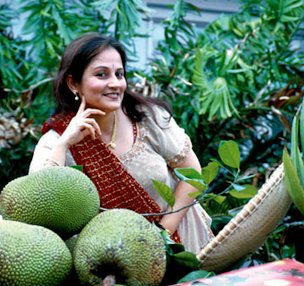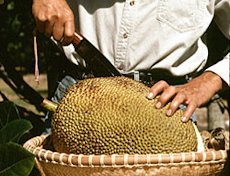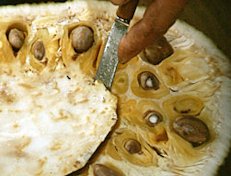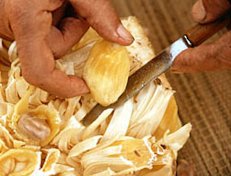From Fairchild
Tropical Botanic Garden
Virtual Herbarium Database
How to use
Jackfruit

The
sheer size of the fruit and copious sticky latex can make preparation
of the fruit a challenge. There are significant differences among
jackfruit cultivars in both size and latex content, and with regard to
latex, the stage of maturity and time of the year can influence the
amount. It is best to use latex gloves or coat hands, knives and work
surfaces with vegetable oil prior to preparation to minimize the
adherence of latex and to ease in clean up.
 |
 |
| Step 1: fruit is cut in half |
Step 2: core is removed |
The
fruit is initially cut in half and the central core cut away. The flesh
bulbs are separated from the rag and the seeds removed. The flesh is
washed, and then patted dry. If not eaten immediately it can be stored
in an airtight bag and refrigerated for up to a week. The flesh can
also be frozen for a year or more, but the texture may suffer.
Cultivars such as ‘Dang Rasimi’, ‘Lemon Gold’,
and ‘Tabouey’ may require 1 hr or more to prepare due to
their large size and the number of flesh bulbs and seeds within each
fruit. Cultivars, such as ‘Cheena’, ‘Cochin’,
‘Golden Nugget’ and ‘Black Gold’ can be
prepared in 15 min or less because the flesh easily separates from the
rag and there is little latex in the fruit.
 |
 |
| Step 3: bulbs are separated from rag |
Step 4: seeds are removed |
The
jackfruit is not only versatile, but also highly nutritious. It remains
at the heart of savory and sweet dishes throughout Southern Asia and as
seen in the Jackfruit Recipes, the health benefits are considerable.
The jackfruit clearly has a place at the table of both the subsistence
farmer, and the modern health-conscious consumer. In its new home in
the Western Hemisphere, the jackfruit continues to gain ground both in
a commercial and home garden arena through a celebration of ethnic
cuisines and modern culinary innovations. Both as a green vegetable and
a ripe fruit, coupled with the traditional ingredients of coconut milk
and seafood or with exciting modern combinations, progressive chefs and
jackfruit pioneers are introducing an ancient delicacy to an eager new
audience. The result is a meeting of East and West, a union beneficial
to the jackfruit, and us all.
Ripe
jackfruit
(100 g edible portion) |
| Vitamin A |
66 ug |
| Riboflavin |
0.06 mg |
| Vitamin C |
7.9mg |
| Energy |
301 kcal |
| Water |
83% |
| Protein |
1.6 g |
| Fat |
0.2 g |
| Carbohydrate |
25.4 g |
| Fiber |
5.6 g |
| Ash |
2.2 g |
| Calcium |
37 mg |
| Phosphorous |
26 mg |
| Potassium |
292 mg |
| Iron |
1.7 mg |
| Sodium |
48 mg |
Back to
Jackfruit Page
|
Copyright © 2007 Virtual Herbarium - All rights reserved
|